China, Rare Earths and Technological Edge
Introduction
A sign at the entrance of China’s Baotou, Inner Mongolia Pioneering Rare Earth Hi-Tech Zone quotes Deng Xiaoping’s 1992 claim: “There is oil in the Middle East, but there is rare earth in China.” The rare earth elements (REE) are a group of 17 chemically similar metallic elements occurring in the Earth’s crust that are becoming increasingly integral to the production of products ranging from smart phones and LED light bulbs to wind turbines and cruise missiles. Since the 1980s, REE mining and processing has increasingly moved to China. Due to factors such as cheaper labor and less stringent environmental regulations, China has been able to produce the elements at two-thirds the cost of non-Chinese producers. As a result, it now produces over 90% of the world’s REEs. China has also been moving from a supplier of unfinished REEs to a manufacturer of high-end REE products and it believes that mastering high-end REE technology will not only help ensure its safety given REE’s many defense applications, but could also allow it to leapfrog the US and other countries in the production, for instance, of green technologies.
China’s monopoly of REEs came to a head in 2008 when it began restricting the amount of unfinished REEs that it exported while increasing REE export taxes and removing REE VAT rebates. International concern was further increased in 2010 when China was believed to have implemented an unofficial REE export embargo against Japan for two months and the US and the EU for two weeks. A 2012 WTO complaint filed against China by the US, the EU and Japan claimed that the effect of these policies has meant that non-Chinese producers of REE products pay 31% more for their REEs than their Chinese competitors. The US, the EU and Japan also say that Chinese practices are placing pressure on foreign manufacturers to relocate their operations to China in order to minimize the impacts of rising costs and shrinking supplies, as China does not restrict or tax the export of REEs in manufactured products. China counters that its policies are necessary to improve the real environmental degradation that its lax standards have caused and to conserve its finite REE resources.
Rare Earth Elements and the History of their Development
The REEs are a group of 17 chemically similar metallic elements including the 15 lanthanides as well as scandium and yttrium. Scandium and yttrium are grouped with the rare earths as they share similar chemical and physical properties. Despite their name, the REEs– with the exception of the radioactive promethium which is currently synthesized in labs – are quite abundant in the Earth’s crust, although their crustal abundance varies significantly from place to place. The “rare” earth name comes instead from the rarity of the minerals from which they were originally derived. It also comes from the fact that the elements are rarely found in concentrations that are viable to mine.
The REEs are broadly divided into light rare earth elements (LREE) – lanthanum, cerium, praseodymium, neodymium, and samarium (atomic numbers 57-62 on the periodic table) and heavy rare earth elements (HREE) – gadolinium, promethium, europium, gadolinium, terbium, dysprosium, holmium, erbium, thulium, ytterbium, lutetium (atomic numbers 64-71). Scandium (atomic number 21) and yttrium (atomic number 39) are usually grouped with the LREEs. This division is somewhat random; sometimes the REEs are divided between light, middle and heavy. LREEs are more abundant than HREEs.
Although approximately 200 minerals are known to contain REEs, most REEs are mined from the minerals bastnaesite, monazite and xenotime. While these minerals usually contain the full range of the elements, either LREEs or HREEs tend to dominate one mineral or the other. For instance, bastnaesite, the most commercially productive source for REEs, tends to house a high percentage of LREEs and a small percentage of HREEs. Monazite, the second most common mineral used as a rare earth ore, also contains more LREEs than HREEs, although it typically has a higher concentration of HREEs than bastnaesite. Xenotime, the third most important rare earth element ore, holds the highest ratios of HREEs. HREEs can also be found concentrated in some soils, absorbed in the form of ions. Bastnaesite, monazite and xenotime all contain traces of the radioactive elements thorium, although the amount varies between the minerals and between ore deposits. The presence of the radioactive element makes REE mining and waste management more difficult.
The first discovery of rare earth materials was made in the late 1800s in Sweden. Given that rare earths occur together and share similar chemical properties, it was a further 150 years until all the rare earth elements were isolated and identified. The last rare earth element to be discovered was the radioactive promethium which was found as a result of nuclear fission research carried out during World War II. In nature, promethium can only be found in trace amounts as it is highly unstable and has a half-life of 17.7 years.
Production of Rare Earth Elements
Until 1948, the majority of rare earths were produced in India and Brazil, followed by South Africa in the 1950s, and the Mountain Pass Mine in California from the 1960s to the 1980s. Since the 1980s, REE mining and processing, and the production of many REE products has moved to China. Between 1990 and 2000, for instance, China increased its REE production from 16,000 to 73,000 metric tons while non-Chinese producers saw their output decline from 44,000 tons to 16,000 tons. In 2009, China produced 129,000 tons while the output from all other countries dropped to 3,000 tons.
China now dominates the REE industry because it can produce REEs and REE products less expensively and with more purity than its competition. Its low cost production is the result of many factors including inexpensive labor, lower environmental standards and a REE industry which has historically been poorly regulated. It is estimated that China’s lower environmental standards have enabled it to produce rare earths at roughly a third the price of its international competitors. China has also made significant investments in REE mining and processing techniques which are now paying off in greater efficiencies. China also mines the majority of their REE as a by-product of their iron ore and other mineral mining, which also reduces their cost basis.
Where Global Rare Earth Resources are Found
The U.S. Geographical Society estimated that in 2008 China held approximately 57.7% of the world REE reserve, the Commonwealth of Independent States (which includes Russia and many former members of the Soviet Union) 13.6%, the US 9.1%, Australia 3.8%, Brazil 0.05%, India 0.84%, Malaysia 0.02% and other countries 14.9%. Additionally, the British journal Nature Geoscience reported scientists led by Yasuhiro Kato of the University of Tokyo, have found huge deposits of REEs in sea mud at 78 locations in international waters east and west of Hawaii, and east of Tahiti in French Polynesia. Japanese scientists have also identified REEs off island of Minamitorishima, an isolated Japanese coral atoll in the northwestern Pacific Ocean.
In China, REEs have been found in 21 of China’s provinces and Autonomous Regions: Fujian, Gansu, Guangdong, Guangxi, Guizhou, Hainan, Henan, Hubei, Hunan, Jiangxi, Jilin, Liaoning, Inner Mongolia, Qinghai, Shaanxi, Shandong, Shanxi, Sichuan, Xinjiang, Yunnan and Zhejiang. In general, China’s REE reserves are distributed in a light north, heavy south pattern. An estimated 75% to 90% of China’s REE output is in LREEs; 50% to -60% of its LREEs comes from its Banyan Obo mine in Inner Mongolia, and another 25% to 30% comes from mines in Sichuan Province. China’s remaining output is HREEs sourced primarily from its ion-adsorption clays located in the provinces of Fujian, Guangdong, Hunan and Jiangxi.Southern China’s ion-adsorption clays are currently one of the most important concentrations of heavy HREEs in the world. Importantly, these clays have extremely low levels of radioactive elements.
Mining and Processing of Rare Earth Elements
Most REEs are mined either by digging in open pits or in underground mines. The ore is then crushed, heated and treated with various chemicals in order to separate first the bastnaesite, monazite and xenotime, and then to separate the REE from the bastnaesite, monazite and xenotime. In order to ensure a high market value, REE needs to be of high purity. This is a difficult process because REEs share such similar chemical properties. Each REE has its own unique extraction steps and refinement processes, and often these elements need to be reprocessed in order to achieve the ideal purity. Once separated, the REEs are in the form of oxides which are then made into metals. It takes an average of 10 days to go from mining to the production of rare earth oxides. China currently leads the world in REE separation processing technology. Chinese companies can produce REEs of 99.9999% purity compared with French companies at 99.99% purity and Japanese at 99.9% purity.
Outside of China, companies in the US, France, Russia and Japan can complete some of the refining steps, but only China has the industrial capacity to complete the entire REE refinement process for all the elements. Mining companies such as US Molycorp and Australian Lynas which extract REEs outside of China currently find it necessary for technological and economical reasons to ship their minerals to China for processing despite their respective efforts to move further down the REE processing chain.
Separating REE from bastnaesite, monazite and xenotime is more difficult than separating REE from the ion-adsorption soils. In Southern China, most of its REEs are found in clay deposits. Not only is it easier to separate REEs from the clay compared with the hard minerals, but it is also usually easier to access the clays in the first place. The ion-adsorption clays are near the crust’s surface, and generally require little drilling or blasting to remove. China’s Jiangxi South Rare Earth Hi-Tech Company has reduced the costs of the clay processing further by pioneering in-situ mining. This method involves drilling holes directly in the clay deposits, pumping in ammonium sulphate or salt-based solutions which remove 90% of the REE from the clay and then collecting the resulting liquid from pipes drilled in at lower levels. The liquid is then pumped into tanks where it is treated with further chemicals, filtered and roasted to produce rare earth oxides.
Uses of Rare Earths Elements
REEs are essential to many products that are fundamental to our modern life. REEs can be found in products as diverse as TVs, plasma screen technologies, microwave filters, ear phones, self-cleaning ovens, flint lighters and computer memories. Because REEs are extremely effective in absorbing ultraviolet light, REEs are used in glass bottles, sunglasses, and camera lenses. Because they allow for the development of powerful permanent magnets – which differ from electrical magnets in that they produce their own magnetic field – REEs create improved magnetic performance in smaller sizes. They are, thus, important in miniaturization technology, and are a key reason why laptops, cell phones and smart pads are becoming increasingly lighter and smaller.
Permanent neodymium-iron-boron magnets are also fundamental to many green technologies, especially wind turbines. Their superior magnetic strength means that they increase the amount of electricity that a wind turbine can produce. REE magnets also have the advantage that they retain more magnetism when heated. These qualities make them ideally suited for the production of hybrid cars. The Toyota Prius, for instance, contains 1 kg of neodymium in each of its electric motors. REE magnets also improve the energy efficiency of many appliances and cooling systems. REE magnets have been shown to reduce the power consumption of air conditioning systems by as much as 50%, and have led to the development of more environmentally friendly refrigeration methods. Energy efficient lighting such as the fluorescent lamp and LEDs are also big users of REEs.
REEs are also employed in other green technology applications. For instance, REEs are essential to the automotive catalytic converter whose job it is to convert pollutants in engine exhaust gases into non-toxic compounds. They also used in oil refineries to process heavy crude oil into lighter gas, jet fuel and petrol. They are also proving essential to the development of solid oxide fuel cells – a low-pollution technology which electrochemically generates electricity at high efficiencies – and other fuel cells which are being developed as power generators for zero emissions electric vehicles.
Besides, the green technology industry, REEs are also found in a wide range of industrial applications. For instance, REEs are employed in many aspects of nuclear energy production because of their ability to absorb neutrons while remaining stable at high temperatures. They are also found in ceramics, glass coloring and in the colors displayed on TV, computer and hand-held screens. They help paint pigment deflect ultraviolet light which makes them less likely to fade. Most finished glass products, such as mirrors, have been shined by REE concentrates and oxides. REEs are also a critical component in the creation of super-alloys or super-metals which are a class of heat resistant alloys used in the aerospace and power industries, particularly in gas turbine engines. REEs are also elemental to the technology that allows for the solid state storage of hydrogen.
REEs are also found in many medical technologies including x-rays and PET scan detectors. REEs not only improve the performance of MRI machines, but they also enable the physical internal scanning space of the machines to be wider, which serves to reduce feelings of claustrophobia for sick patients. Medical lasers produced with REEs are used in the cosmetic industry to remove pigmentation and scarring on skin, as well as in many other surgical procedures. There are also increasingly used in dentistry to remove tooth decay.
REES are crucial for the defense industry. They can be found in disk drive motors installed in aircraft, tanks, and command and control centers, and in radar systems and in reactive armor. They are key to the production of precision guided munitions, helping to guide the direction of the missile once it is launched. They are fundamental to lasers employed in enemy mine detection equipment, underwater mines and other countermeasure weapons systems. REEs are also found in components used in military communication networks including satellite, radar and sonar. They are also used in optical equipment and speakers.
In 2011, the US Geological Society estimated that the global use of rare earths broke down as follows: catalysts 47%, metallurgical applications and alloys 24%, glass polishing and ceramics 15%, permanent magnets 9%, computer monitors 19%, radar, television and x-ray machines 5%.
Environmental Consequences of Rare Earth Mining
The manufacture of REEs poses significant environmental hazards because of the large amounts of chemicals used in processing and because the processing waste often contains toxic gases and traces of the radioactive thorium. In northern China’s Bayan Obo (Baiyun Ebo) mine in Inner Mongolia, for instance, REEs are mined and then transported 120km south to Baotou to be processed. Dozens of new factories have been built around Baotou’s processing facilities in what has been called Baotou’s Pioneering Rare Earth Hi-Tech Development Zone. A coal-fuelled power station supplies electricity to Baotou’s large and growing industrial complex.
The Chinese Society of Rare Earths estimated that for every ton of rare earth oxide it produces in Baotou, China generates up to 12,000m³ of waste gas containing dust concentrates, sulfur dioxide, hydrochloric acid and sulfuric acid, and about 2000 tons of mine tailings. Tailings are the ground materials left over once the REEs have been removed from the ore. In northern China, these tailings contain traces of radioactive thorium. In addition, it is estimated that all factories and processing facilities in the Rare Earth Hi-Tech Development Zone create approximately 10 million tons of all types of waste water every year. Much of this waste water along with an estimated 7-8 million annual tons of mine tailings are dumped into what has grown into an approximately 11km² waste impoundment lake without being effectively treated. A 2006 Chinese report undertaken by local authorities found that the level of thorium in soil near the lake was 36 times higher than in the soil in other areas of Baotou. From the lake, the chemical and radioactive waste has seeped into the ground water. The waste has also found its way into the Yellow River which passes to the south of Baotou before continuing another 1300 miles to the Yellow Sea. The Yellow River is subsequently used as a water supply for a large concentration of China’s population, including the residents of Beijing and Tianjin.
Around Baotou, most fish in the Yellow River have died. Agriculture has also been severely affected as lake wastewater has contaminated irrigation water supplies and the soil. Local farmers say that since the 1980s, fruit trees have either yielded no fruit or that the fruit they do grow is small and foul-smelling. Vegetable plants have stopped producing and many livestock in the area have become ill and died.
Residents inhaling the vapors and drinking the contaminated water have noticed higher incidents of diabetes, osteoporosis, respiratory diseases, leukemia and other cancers, skin and eye irritations, irritation to the gastrointestinal tract, black lung disease and kidney damage.
China’s southern REE mining and processing operations have also caused significant environmental degradation. The in-situ extraction method, which was hoped to be less environmentally damaging, has also resulted in reduced or eliminated crop yields and in fish dying in the rivers in the areas around which it is being mined. One issue in the south has been the extensive presence of illegal mines which are particularly prone to releasing toxic waste into the general water supply.
Until recently, China has never had firm pollutant discharge standards for the rare earth industry. Additionally, it poorly enforces the regulations that do exist. This lack of stringent environmental regulation and enforcement has meant that China’s REE industry produces REEs at roughly a third the price of its international competitors. While some Chinese REE companies have tried to improve their mining processes to make them more environmentally friendly, many have chosen to keep their environmental costs to a minimum in order to maintain a competitive edge in the market. In addition, as the government owns the land on which the factories lie, companies have little incentive to protect it. Additionally, China’s still-developing legal structure means that people and companies cannot easily be held accountable through the country’s judicial system. In Western countries, if employees or residents become ill due to unsafe production methods, those responsible would likely face due process which could result imprisonment and fines. This is not the case in China, unless victims have the support of the government. Yet the government often has a stake in the REE production process which acts as an incentive for the REE processing to continue untouched.
Characteristics of China’s Rare Earth Industry before Government Reform
Starting in 2000, China’s government began to re-evaluate its REE strategy in the light of its rapid development, the poor profitability of its rare-earth producers and the rapidly growing demand for REEs worldwide. While its achievements in the REE field since 1978 are undeniable, the government has become increasingly concerned about a number of issues. These issues were outlined in Situation and Policies of China’s Rare Earth Industry published by the Information Office of the State Council of the People’s Republic of China in June 2012 and included: severe ecological damage to the environment, excessive exploitation of REE resources, poor profitability of the REE industry causing what it considered to be a severe divergence between the price and the value of REEs, and the illegal mining and sale of REEs.
While the environmental degradation that has been caused by China’s REE production is quite widely known, part of the purpose of the China’s REE report was to inform on the other challenges that China faces in managing its REE resources. Specifically, China found that 50 years of aggressive mining of its REE resources have significantly reduced its reserves. In Baotou, for instance, the report stated that only about one third of the original volume of REE resources was left in its principal mines. In its ion-adsorption clays, the reserve extraction ratio – the remaining supplies of REE in years – has declined from 50 years of remaining resources 20 years ago to 15 years of REE resources today.
While China publishes the country’s REE data yearly, these reports are not available to foreign researchers. Independently verifying the PRC’s calculation of its reserve levels has thus been difficult. For instance,
s China’s Situation and Policies of China’s Rare Earth Industry paper calculated that China holds 23% of the world’s reserves, while the 2008 US Geological study calculated that China held 58% and a 2011 British Geological Survey Rare Earth Elements paper calculated that China held 44%. That said, there can be no doubt that China has seen a rapid depletion of REE reserves in the last three decades.
China has also expressed concern about the poor profitability of the REE industry. Historically, the Chinese REE industry has been characterized by numerous, relatively small-scale enterprises, particularly in the south, which often engage in cutthroat competition. This has often meant that REE producers have often struggled to maintain profitability. Yet, as many local governments have relied on REE producers to provide employment and revenue, they have continued to encourage local production even it means exceeding national production targets. As a result, China feels that it REE resources have been sold at prices which do not reflect their real value or take into account environmental costs. To support this argument, China cites the fact that between 2000 and 2010 the price of rare earth products increased by 2150%, while the prices of gold, copper and iron all increased by in excess of 4300%.
China’s REE has also been plagued by illegal mining and smuggling. The report states, that from 2006 to 2008, statistics collected from foreign customs offices were 35%, 59% and 36% higher than the volumes that China officially exported over this time period. In 2008, it was estimated that approximately 29,000 tons of rare earth materials were smuggled out of the country, representing an estimated one-third of total REE exports. In 2014, it was estimated that illicit sales rose to 40% of all REE production or as much as 40,000 tons. Illicit REE materials are often hidden as steel composites, then reverse-engineered out when they reach the customer’s home country. It is believed that Japan is the largest importer of illicit REE materials, and may get as much as 20% of its REEs from China’s black market. Smuggling hurts China’s rare earth industry both by depressing prices, more quickly depleting REE resources and by increasing environmental damage as smugglers usually pay scant attention to pollution management.
Rapid Increase in Domestic Demand for REE Products
China has also seen a rapid increase in domestic demand for REEs, and it expects this demand to continue to increase in the future. In 2000, for instance, Chinese REE consumption was about 19,000 metric tons while non-Chinese usage was about 72,000 tons. By 2009 Chinese REE consumption had reached about 73,000 tons while other usage had declined to 59,000 tons. China uses more REEs today as its REE industry is moving higher up the manufacturing value chain. For instance, its 1987 production of products such as catalysts, magnets, phosphors, and polishing powder represented only about 1% of the total REE that it consumed. By 2008, the production of these products accounted for about 53% of the REEs used in China. Going forward, China expects its REE use in the new material technologies to grow faster than in its other traditional industrial sectors.
As an example, in July 2008, China had approximately 600 million mobile phone users; by November 2012 China’s Ministry of Industry and Information Technology estimated that China’s mobile phone owners had exceeded one billion. Similarly, in 1998, the United States, Europe and Japan produced 90% of the world’s permanent neodymium-iron-boron magnets; today China manufactures 76% of the world’s total. In 2009, China produced 12,000 gigawatts of wind power; by 2015, China aims to have 100 gigawatts of on-grid wind power generating capacity, and to be generating 190 billion kilowatt hours (kWh) of wind power annually.
China’s Reform of its Rare Earth Industry
As early as 1990, the Chinese government deemed REEs to be a strategic mineral critical to China’s long-term political, economic and military power and began restricting foreign investors from mining rare earth, or from participating in smelting and separating except in joint ventures with Chinese firms. By 2000, Chinese scientists and military experts were calling for even greater controls over its REEs. In 2005, Xu Guangxian, China’s leading REE scientist, argued that at the current rate of extraction the Bayan Obo mine would be depleted in 35 years.
As a result, the Chinese government began to implement a number of initiatives designed to reform the industry. Laws regarding REE mining, production and waste management were reviewed, and efforts have since been made to improve enforcement. Additionally, in 2005, the government eliminated the value-added tax rebates for REEs, and taxes on the export of unimproved REEs were raised. The government also reduced the number of REE mining and processing licenses issued. In 2006, 47 domestic REE producers and 12 Sino-foreign rare Earth producers were licensed to export rare earth products from China. By 2011, that number had dropped to 22 domestic REE producers and 9 Chinese-foreign joint venture REE producers. It has also begun to stockpile REE materials with the goal of reaching reserves of 30,000 to 55,000 tons of rare earth concentrates.
Additionally, it created the 2009-2015 Plan for Developing the Rare Earth Industry, and established the Chinese Society of Rare Earths, consisting of 150 members whose aim is to develop a fully integrated REE sector. Part and parcel of this, it has divided the country into large REE districts: Jiangxi, Guangdong, Fujian, Hunan, and Guangxi in the South; Inner Mongolia and Shandong in the North; and Sichuan in the West. Between 2009 and 2015, the government expects Inner Mongolia and Sichuan to be primarily responsible for producing LREE with additional capacity coming from Shandong as needed. HREEs will be produced in Jiangxi, Guangdong and Fujian. Increased inspections by government officials will be carried out in order to ensure that facilities are not exceeding national quotas and that mining and manufacturing are meeting environmental regulations.
Since January 2014, China has pressed aggressively ahead with its efforts to consolidate the REE industry under six large state owned enterprises (SOE)including Inner Mongolia Baotou Iron and Steel Group, China Minmetals Corporaion, Aluminum Corporation of China (Chinalco), Guangdong Rare Earth Group, Xiamen Tungsten, and Ganzhou Rare Earth Group. These SOEs will control the industry by geographic region. An estimated 300 smaller, independent REE producers have been forced to shut down or to merge with the SOEs. These SOEs will invest in all aspects of the rare earth industry chain. Currently, these six companies control 94% of China’s RE resources, 75% of its mines and 60% of the smelting and separating capacity. After consolidation, the six SOEs are expected to have complete control over these sectors. These conglomerates will be supported by financial subsidies, tax breaks, and other form of government investments, and will be encouraged to expand their expertise in areas such as REE recycling.
China continues to view the REE industry as of strategic importance to the country. Its goal is to have a significant market share of the entire REE supply chain from mining, smelting and separating to manufacture of high-end rare earth technologies. China’s dominance in the middle aspects of the REE supply chain – transforming mined materials into useful ingredients – enables China to draw in related domestic and multinational businesses that depend on the REE materials. This in turn increases China’s importance to supply chains in everything from mobile phones to wind turbines.
Since January 2014, Beijing has also stepped up its campaign against illegal mining. It has forced smaller, wildcat producers to close, and is now conducting helicopter searches in areas where illegal mines are purported to be operating. It is also going after the gangs who are running them as well as local government officials who turn a blind eye.
Beijing is also working to stamp out illegal production by larger, licensed companies which avoid production quotas by exporting RRE under ambiguous labels such as “iron alloy”. New export license paperwork for the big six will be more onerous and exacting. Beijing is also trying to implement a RE supply chain trace-ability system.
Since July 2014, China has push ahead with its plans to grow its domestic REE stockpiles. China plans to use it stockpiles to ensure adequate resource supply in the future, especially in light of growing domestic demand. It will also use it stockpiles as a mechanism to support REE pricing.
Export Quotas
The government also began to implement quotas on the amount of REEs that it allowed to leave the country. From the Chinese perspective, quotas felt appropriate as foreign countries, particularly the United States and Japan, were seen to be taking advantage of China’s cheap, environmentally-destructive REEs while maintaining strategic stockpiles in their own un-dug mines. Quotas would also help ensure that the Chinese had plenty of REEs for their domestic needs. Historically, separate export quotas have been set for domestic REE producers and for Sino-foreign joint venture REE producers. Between 2005 and 2007, the government authorized domestic REE producers to export 40,000 metric tons and Chinese-foreign joint ventures to export 16,000 metric tons. In 2008 and 2009, China reduced the domestic quota by 21.6% and 2.5% respectively while holding the Chinese-foreign joint venture quota steady. By 2010, China’s overall REE export quota was reduced an additional 37.1%, this time impacting both domestic and Sino-foreign joint venture producers alike.
The government’s new policies are specifically designed to restrain the export of unprocessed REEs, as no quotas have been placed on REEs exported in finished products. Part of the reason for this is that the government wants to encourage foreign REE manufacturers to relocate their production facilities to China, particularly to Baotou’s Pioneering Rare Earth Hi-Tech Development Zone. It is estimated that approximately 50 foreign companies are already operating within Baotou’s industrial complex. From the Chinese perspective, this would allow them access to new technology and would generate jobs for its citizens. Non-Chinese consumers of REEs have criticized this policy saying that it is pressuring them to relocate to China in order to stay cost competitive. This in turn could put their proprietary REE technology at risk, and it would continue international dependence on China’s REE industry.
Chinese Suspension of Rare Earth Exports
On September 7th, 2010, a Chinese fishing trawler rammed a Japan Coast Guard vessel near to the Senkaku/Diaoyu disputed islands, known in Japan as the Senkaku Islands, and in China as the Diaoyu Islands. The islands are administered by Japan but are also claimed by China and Taiwan. The Japanese subsequently detained the captain, causing a major diplomatic dispute between the two countries. Despite repeated demands by the Chinese government, the Japanese refused to release the captain, saying that instead his case would be handled by the Japanese courts. In retaliation, the Chinese canceled official ministerial Sino-Japanese meetings, and revoked an invitation for 1000 youths to attend the Shanghai World Expo. (Lin, 2010) Although denied by the Chinese government, on September 21st, it is widely believed that the Chinese also orchestrated an unofficial halt of REE exports to Japan by having its custom agencies prevent the export of REEs, though this has recently been questioned in academic studies, particularly in light of the fact that shipments to Europe and the US were also halted the following month, and given that the Japanese government had expressed grievances over the rare earths issue as early as August 18th. Beijing claimed instead that the export stoppage was a spontaneous, independent demonstration of support by Chinese REE exporters and custom agents. Regardless of its origin, the embargo has enabled China to exert political pressure on Japan. The unofficial nature of the embargo also made it more difficult to challenge in the World Trade Organization (WTO) which bans most unilateral export stoppages. On September 24th, Japan released the Chinese captain, with the Chief Prosecutor citing “Japan’s national interests”.
By mid-October 2010, China was also blocking some shipments to the United States and Europe after the Obama administration opened an investigation into whether China was violating free-trade rules with its green energy policies including its restrictions on REEs. China resumed shipments to the U.S. and Europe at the end of October, but did not resume shipments to Japan until the November 24th. Part of its decision to resume shipments to Japan might have been due to the fact that many Chinese assembly factories, employing hundreds of workers, were running low on Japanese-made components when suppliers began to face shortages of some of the REEs needed in their manufacture.
Consolidating the Industry and Ending Illegal Mining and Smuggling
Since 2006, the government has stepped up its efforts to shut down illegal mines in the provinces of Guangdong, Jiangxi and Sichuan. Over the last two years, China has investigated and rectified 600 cases of illegal mining, has identified an additional hundred cases against which further action will be taken, and has closed 13 mines and 76 processing facilities. Similarly, in 2011, China launched a campaign to crack down on REE smuggling, retrieving 769 tons of smuggled REE metals and prosecuting 23 criminal suspects in eight cases.
China has also been urging its REE producers to merge together. Ultimately, the government envisions that the REE industry will be eventually controlled by a few, state owned enterprises. Surviving Chinese producers have seen advantages to this consolidation strategy as it has helped to reduce unnecessary competition and increase profitability. For instance, Dingnan Dahua New Materials Co., Ganxian Hongjin Rare Earths Co. Ltd, Minmetals Nonferrous Metals Co. Ltd have all joined together to form Minmetals Ganzhou Rare Earth Co. Ltd to process REEs in Ganshou, Jiangxi Province. Their operations are expected to slowly subsume the majority of the production of the 88 smaller REE producers that have historically been operating in the area.
Improving Environmental Regulation
China also plans to implement stricter environmental standards. The Ministry of Environmental Protection has now set discharge standards for six types of atmospheric pollutants and for 14 different types of water pollutants. China will aim for its new REE facilities to be built to ISO 9000 and ISO 14000 certificate standard. It may also force its dirty mining and processing facilities to halt operations until they are also able to secure the ISO accreditation. The ISO 9000 and ISO 14000 are internationally recognized accreditations that look at how a product is produced rather than the product itself. The ISO 14000 standards help organizations establish procedures that minimize negative effects to the environment. If China enforces its tougher environmental standards, it is estimated that it could add between $145 and $220 to the production costs of every ton of REE products. These higher costs would significantly erode China’s cost advantage in the industry.
Additionally, China intends to increase the recycling rate of both REEs in discarded electronic products as well as recycling an estimated 12.6 million tons of REE oxides that had been deposited in its Baotou tailings pond. Currently there are no cost-effective ways to recycle rare earth elements from old equipment such as computers, electric motors and cell phones. Similarly, technology to extract residue REEs in tailings ponds is also in need of further development. China is also working on technology that will reduce the amount of REEs that are flushed into tailings ponds in the first place.
China’s Rare Earth Industry Research and Investment
As China considers its REE industry to be of critical strategic importance, it is heavily investing in REE research and development. It hopes breakthroughs in REE technology will help ensure its national security, and could enable China to leap-frog the West to lead in the development of many new advanced technologies such as those found in the rapidly emerging environmental sector. Indeed, in 1999 President Jiang Zemin noted that if China could master REE technology, its REE resource advantage could then help lead China to economic superiority.
Much of China’s REE investment has been funneled through the State Key Laboratory of Rare Earth Materials Chemistry and Applications, affiliated with Peking University in Beijing, and the State Key Laboratory of Rare Earth Resource Utilization, affiliated with the Changchun Institute of Applied Chemistry which is run under the direction of the Chinese Academy of Sciences. Between the two labs, there are approximately 70 faculty members, 35 professors and 75 graduate students dedicated to REE research. Additionally, China also conducts REE research through the Baotou Research Institute in the General Research Institute for Nonferrous Metals. Each of these institutions run complementary but independent research into the efficient and environmentally friendly mining and processing of REEs, the development of technology employing REE materials, the recycling of REEs from already existing products and the reclamation of REE materials in its extensive waste ponds.
China is not only investing in REE domestically, it is also purchasing stakes in rare earths natural resources abroad. For instance, China has purchased a 25% date in Arafura Resources Ltd, an Australian Rare Earth developer.
World Response to the Reform of China’s Rare Earth Industry – WTO filing
In March 2012, the United States, European Union, and Japan filed a complaint with the WTO against China’s REE trade practices in response to export restrictions, restrictions in export licensing, higher export taxes, and the withdrawal of the 16% refund of value-added tax on exports of unimproved REEs. They argued that the effect of these policies has been that non-Chinese producers of REE products pay 31% more for their REE materials than their Chinese competitors. The US, EU and Japan are also challenging aspects of the allocation and administration of export quotas, export licenses and the manipulation of export prices. They contend that Beijing aims to satisfy domestic REE demand first, and to control the international price of REEs abroad. They also say that Chinese practices are placing pressure on foreign manufacturers to relocate their operations to China in order to minimize the impacts of rising costs and shrinking supplies. It is expected that the complaint will take between one and three years to resolve.
China has countered that its policies are intended to improve the environmental standards of its REE mining and processing facilities as well as to promote the long-term economic sustainability of its REE resources. It has rejected a call for the establishment of a WTO panel. China has also countered that foreign suppliers have not complained of China dumping low-cost REEs as they previously had with China’s export of low-priced steel and textiles.
The US, EU and Japan feel that a WTO ruling made in January 2012 supports their case. In that ruling, the WTO decided that price and quantity controls primarily targeting foreign entities were not a reasonable implementation of a resource conservation policy. It also stated that trade restriction measures for the purpose of environmental protection can only be applied in conjunction with restraints on domestic production or consumption.
In June 2014 the WTO ruled against China and in August 2014 China lost its appeal. The WTO stated that China’s efforts conserve its limited REE resources and to protect its environment by restricting foreign access to REE tungsten and molybdenum through export duties, export quotas, minimum export pricing requirements and additional requirements and procedures constitute a breach of WTO rules. Instead the WTO found that the China’s REE restrictions were designed to achieve industrial policy goals rather than REE resource conservation or environmental protection. The WTO ruled this because no measures were put in place to restrict domestic access to REE supplies. Instead the export restrictions gave domestic companies preferential access to REEs at prices below that available to foreign customers.
World Response to the Reform of China’s Rare Earth Industry – Developing New Rare Earth Sources
Many governments and companies around the world are also beginning to develop new REE sources, now feasible given the higher REE prices which have resulted from increased REE demand and China’s export restrictions. The Australian company Lynas Corporation, for instance, has invested in an $800 million processing plant located on Malaysia’s East Coast. Once fully operational, Lynas’s Malaysian processing plant is slated to become one of the largest REE processing plants in the world. Yet, the opening of the plant has been plagued by protests from Malaysian activists who worry about its environmental implications. The plant is located on reclaimed swampland just 12 miles from Kuantan, a city of 600,000 people. A particular worry is that the plant’s toxic wastewater, containing chemicals and low levels of thorium, will seep into the groundwater, and that its storage ponds could become vulnerable to the monsoons that inundate the swampy coastline each autumn. Currently, Mitsubishi Chemical is investing $100 million to clean up its Bukit Merah REE processing site which it was forced to close in 1992 when local residents began complaining of leukemia and other ailments tied to thorium contamination. This environmental contamination has caused Malaysian activists to demand greater environmental regulation for all future RE processing facilities located on its soil.
In California, near Death Valley, Molycorp Minerals has invested $781 million in the modernization and expansion of its RE mining and manufacturing facilities that were shuttered in 2002 when it was unable to produce REEs at prices which could compete with Chinese producers. Molycorp aims for its newly refurbished Mount Pass facility to be one of the most technologically advanced, energy efficient and environmentally friendly REE processing operations in the world. By the end of 2013, Molycorp expects Mountain Pass to be producing 40,000 metric tons of REEs annually. As the US currently consumes between 15,000 and 18,000 metric tons of rare earth oxides each year, this would mean that the US would turn into an exporter of REE products in the near future.
Mines are also under consideration in Canada, Australia, South Africa, Greenland, Mongolia, Vietnam and India. In 2009, Japan signed a contract with Vietnam to invest in a rare earth mine that will produce solely for Japanese vehicle manufacturers. The problem is even if these new mines and accompanying processing plants were given the go-ahead, it could still take between 3 and 10 years, not to mention hundreds of millions of dollars, before these new projects would become fully operational. Others are investing more heavily in the manufacturing of high-end REE products outside of China. Japan’s Hitachi Metals Company, for instance, is investing in a permanent magnet factory in China Grove, North Carolina instead of locating it in China as it had originally envisioned.
A concern for those investing in new REE mining and processing locations is that China could increase production again driving down REE prices just as their projects come on line, once again making non-Chinese mining and processing facilities uneconomical. Ironically, a WTO judgment in favor of the US, the EU and Japan could have this effect by forcing them to withdraw export restrictions which would once again flood the market with Chinese REE product. To protect against this, some non-Chinese scientists and industrialists have called for their governments to provide federal support in the form of loan guarantees and other assistance. Others argue that the rapidly growing demand for REEs should help maintain prices, even in the event of a significant increase in Chinese REE production.
World Response to the Reform of China’s Rare Earth Industry – Other Initiatives
International consumers of China’s REEs are also taking other steps to become independent from Chinese supplies. As a short term stop-gap, countries such as Japan and South Korea already have strategic stockpiles of rare earth metals. Countries are also increasing research into REE substitutes and REE recycling.
Trends for the Future
China’s REE industry continues to grow at a strong clip. According to the Industrial Minerals Company of Australia, China’s REE annual output is forecasted to rise from 105,000 tons in 2011 to approximately 130,000 tons by 2016.
China considers the development of REE technologies a national priority. To support this objective, it will continue to invest heavily in research and development in all aspects of REE production from improved mining efficiency to the development of cutting-edge REE technologies. It will also continue to invest in technologies that will allow it to reclaim REEs from its tailing ponds and to recycle REEs from discarded electronic products.
China should be able to have substantially greater influence over REE’s supply and the pricing. To some extent this will offset its inability to control supply and price by export quotas and by other trade restrictions now ruled to be illegal by the WTO. China will also continue to build domestic stockpiles.
The financial and academic resources China is investing in basic REE research are unparalleled anywhere in the world. Similarly, no other country has identified the manufacturing of REE technologies as a national objective and is pursuing it as single-mindedly. Given China’s significant level of naturally occurring REE reserves, its destination as a low-cost manufacturing base, and its heavy research and investment in all aspects of the REE sector, it can be expected that China will continue to rapidly consolidate its already strong foothold in the manufacture of many of the REE technologies. It is likely it will dominate the production of many of these technologies in the future.
Rising REE prices and aggressive Chinese REE policies have caused non-Chinese REE miners and manufacturers to seek alternative REE sources and alternative locations to produce their REE components. Over the next 10 years, it can be expected that new REE mining and processing sources will come on line, allowing international competitors to claw back some unfinished REE market share. In particular, US Molycorp and Australian Lynas both have brought REE mines on stream. Similarly, international REE producers, wary of the Chinese subsuming their technology, will continue to seek alternative, cost-effective places to manufacture. That said, they will struggle to compete against China’s advantages.


![By Jurii (http://images-of-elements.com/praseodymium.php) [CC-BY-3.0 (http://creativecommons.org/licenses/by/3.0)], via Wikimedia Commons](https://chinafolio.com/wp-content/uploads/2013/03/Praseodymium-300x300.jpg)
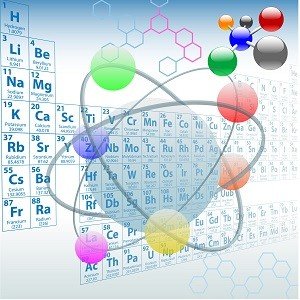

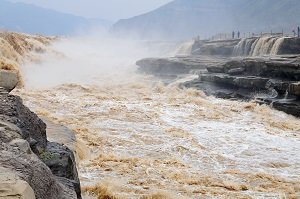



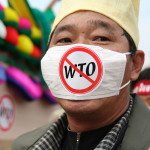




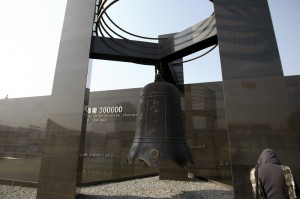
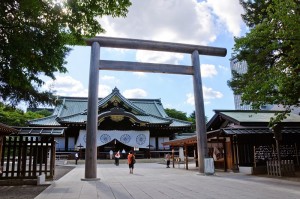


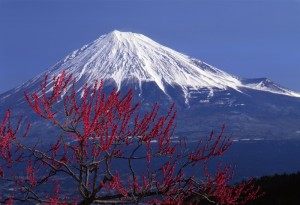
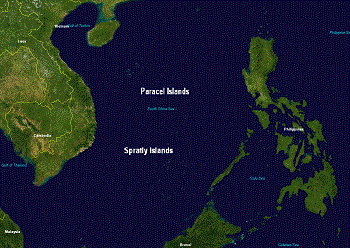
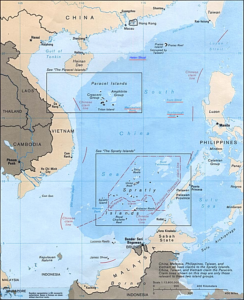
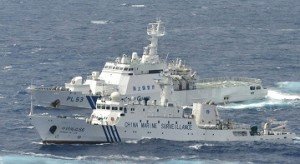
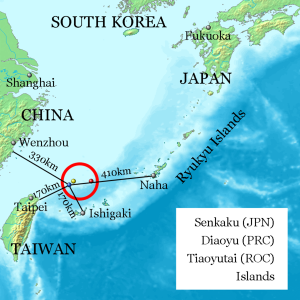
![By Wuyouyuan (Own work) [CC-BY-SA-3.0 (http://creativecommons.org/licenses/by-sa/3.0)], via Wikimedia Commons](https://chinafolio.com/wp-content/uploads/2013/03/Diaoyu_dao_quanjing_poster_IMG_1456A.jpg)

![By 中国海监总队/China Marine Surveillance (中国海监总队/China Marine Surveillance) [Public domain], via Wikimedia Commons](https://chinafolio.com/wp-content/uploads/2013/03/2012_China_anti-Japanese_demonstrations_in_Beijing-300x162.jpg)

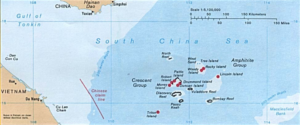


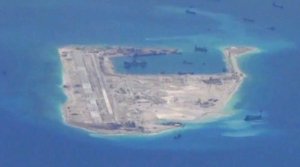 In 2014, China initiated dredging operations to build artificial islands around seven reefs near the Spratly Islands despite competing claims by Taiwan, Vietnam, the Philippines, and Malaysia. China is also building and fortifying an island on the strategic Scarborough Shoal, located 140 miles west of the large Philippine island of Luzon, and on Woody Island in the Paracels, located close to the Vietnam shore. By mid-2015, China’s land reclamation project had constructed almost 2000 acres of new land. On one artificial island built on Fiery Cross Reef near the Spratly Islands, China has built military barracks, weapon delivery systems, radar installations, jamming technology, lookout towers, and runways that have been used for the deployment of Chinese fighter jets. This military buildup is allowing China to significantly strengthen China’s anti-access/area-denial capacity and to increase its projection of force throughout the region. This projection includes an increase in the deployment of surveillance aircraft and guided-missile destroyer patrols as well as the actuation of radar, satellite, and other military surveillance equipment. These efforts have markedly increased China’s military presence in the South China Sea and significantly upgraded its peace and wartime positions. These islands are also creating facts on the ground which enable China to strengthen its de facto control over the water and the territory within its nine-dash line.
In 2014, China initiated dredging operations to build artificial islands around seven reefs near the Spratly Islands despite competing claims by Taiwan, Vietnam, the Philippines, and Malaysia. China is also building and fortifying an island on the strategic Scarborough Shoal, located 140 miles west of the large Philippine island of Luzon, and on Woody Island in the Paracels, located close to the Vietnam shore. By mid-2015, China’s land reclamation project had constructed almost 2000 acres of new land. On one artificial island built on Fiery Cross Reef near the Spratly Islands, China has built military barracks, weapon delivery systems, radar installations, jamming technology, lookout towers, and runways that have been used for the deployment of Chinese fighter jets. This military buildup is allowing China to significantly strengthen China’s anti-access/area-denial capacity and to increase its projection of force throughout the region. This projection includes an increase in the deployment of surveillance aircraft and guided-missile destroyer patrols as well as the actuation of radar, satellite, and other military surveillance equipment. These efforts have markedly increased China’s military presence in the South China Sea and significantly upgraded its peace and wartime positions. These islands are also creating facts on the ground which enable China to strengthen its de facto control over the water and the territory within its nine-dash line.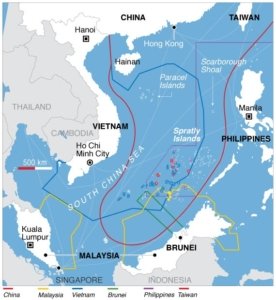 In 2013, the Philippines commenced an arbitral proceeding against China under articles 286 and 287 of United Nations Convention of the Law of the Sea. In its claims against China, the Philippines declared: that China’s nine dash line was invalid; that certain maritime features were claimed by both China and the Philippines; that China was unlawfully utilizing the living and nonliving resources in the Philippines’ exclusive economic zone and in the Philippines’ continental shelf; that the Philippines was being prohibited from reaping the benefits of said resources; that China had broken its responsibilities to protect and conserve the marine environment through its gathering of endangered marine species and coral as well as through the erection of artificial land features; and finally that China was unsafely maneuvering government vessels in a manner that was marring the navigation of Philippine vessels.
In 2013, the Philippines commenced an arbitral proceeding against China under articles 286 and 287 of United Nations Convention of the Law of the Sea. In its claims against China, the Philippines declared: that China’s nine dash line was invalid; that certain maritime features were claimed by both China and the Philippines; that China was unlawfully utilizing the living and nonliving resources in the Philippines’ exclusive economic zone and in the Philippines’ continental shelf; that the Philippines was being prohibited from reaping the benefits of said resources; that China had broken its responsibilities to protect and conserve the marine environment through its gathering of endangered marine species and coral as well as through the erection of artificial land features; and finally that China was unsafely maneuvering government vessels in a manner that was marring the navigation of Philippine vessels.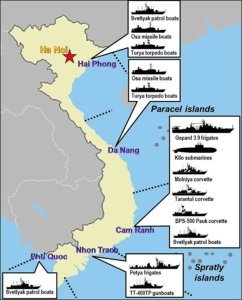 Secondly, many of China’s neighbors in the region are seeking individually and together to balance against China’s rise. This is evidenced first by the fact that defense spending in Asia is growing more rapidly than in any other region in the world. Specifically, it is estimated that between 2016 and 2020, the littoral states of South China Sea are expected to increase defense spending by 50%. There is also been an increase in joint military cooperation between many of the East and Southeast Asian countries including Japan, South Korea, Australia, India, and Vietnam, and with East and Southeast Asian countries and the United States. This growing Asian military spending and this increase in inter-Asian alliances reflects a recognition of a decreasing ability and willingness on the part of the United States to project its power within Asia.
Secondly, many of China’s neighbors in the region are seeking individually and together to balance against China’s rise. This is evidenced first by the fact that defense spending in Asia is growing more rapidly than in any other region in the world. Specifically, it is estimated that between 2016 and 2020, the littoral states of South China Sea are expected to increase defense spending by 50%. There is also been an increase in joint military cooperation between many of the East and Southeast Asian countries including Japan, South Korea, Australia, India, and Vietnam, and with East and Southeast Asian countries and the United States. This growing Asian military spending and this increase in inter-Asian alliances reflects a recognition of a decreasing ability and willingness on the part of the United States to project its power within Asia.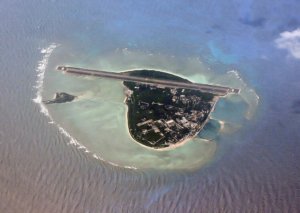 Finally, despite the costs to China’s international position and various bilateral relationships, its strategic and military position has been unquestionably strengthened in various parts of the South and East China Seas. It now controls, or has access to, several strategic positions that previously it did not. From a purely traditional military point of view, this can be viewed as a significant success and a gain in the balance of power in the region. China can be expected to consolidate these gains over the coming decade, all the while working to not antagonize the US or its Asian allies to the point of confrontation as it tightens its hold on the region. That said, China’s more aggressive stance increases the chance that confrontation could result from misstep or from misunderstanding.
Finally, despite the costs to China’s international position and various bilateral relationships, its strategic and military position has been unquestionably strengthened in various parts of the South and East China Seas. It now controls, or has access to, several strategic positions that previously it did not. From a purely traditional military point of view, this can be viewed as a significant success and a gain in the balance of power in the region. China can be expected to consolidate these gains over the coming decade, all the while working to not antagonize the US or its Asian allies to the point of confrontation as it tightens its hold on the region. That said, China’s more aggressive stance increases the chance that confrontation could result from misstep or from misunderstanding.